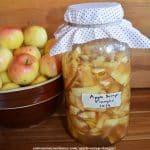Apple Scrap Vinegar Recipe
Easy, inexpensive homemade apple Cider vinegar made from apple scraps.
Ingredients
- Apple scraps, about a quart – you may use cores, peels or even chunks of banged up apples. Just don’t use anything rotten or moldy.
- 1/2 cup sugar (or honey)
- 1 quart warm water
- 2 tablespoons raw apple cider vinegar (optional)
If you want to make larger batches, just keep the same ratios.
Instructions
Mix sugar in water to dissolve. In a 2 quart mason jar or other large, nonreactive container (use glass, food grade plastic or stainless steel) add apple parts and enough sugar water to cover.
I like to fill the 2 quart mason jar about half full of apple scraps, then cover with a quart of sugar water. This gives you ample room to mix without spilling, and also allows plenty of room for bubbles formed during fermentation.
Add raw apple cider vinegar, if desired. This isn’t absolutely needed, but will help jumpstart the ferment. If you have had mold issues in your ferments before, the vinegar is a good safeguard.
Stir vigorously and cover opening with a cloth and rubber band to keep out fruit flies but allow natural yeasts in. Initially the smell should start out like apples and hooch (the microbes will produce alcohol before they switch to vinegar), then the sour vinegar smell will develop.
I do not use a weight to keep the apple scraps down, but I do stir them daily and push them below the liquid.
Keep jar at room temperature and stir daily for about a week. Strain out apple chunks and compost them (or give them to the chickens).
Return to fermenting vessel with airlock or cloth cover and ferment for 2-3 more weeks, stirring occasionally.
Strain and bottle.
Use for cooking, cleaning, critters or health, and enjoy your homemade vinegar that only cost you pennies to make.
Notes
Make sure to use clean, non-chlorinated water. Many municipalities add chlorine to the city water. This will kill your vinegar yeast. Use filtered water, distilled water, well water – anything that doesn’t have chlorine and is safe to drink.
Find it online: https://commonsensehome.com/apple-scrap-vinegar/
